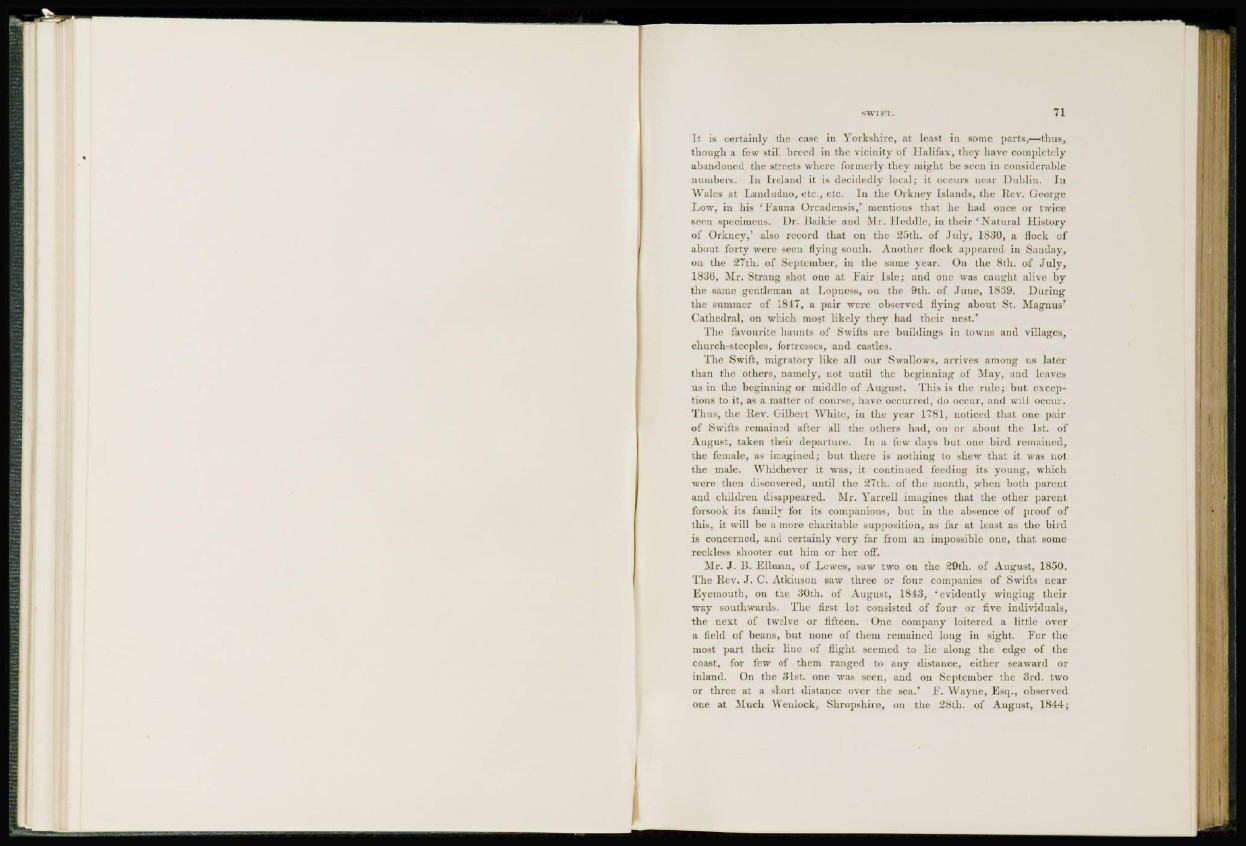
It is certainly the case in Yorkshire, at least in some parts,—thus,
though a few still breed in the vicinity of Halifax, they have completely
abandoned the streets where formerly they might be seen in considerable
numbers. In Ireland it is decidedly local; it occurs near Dublin. In
Wales at Landndno, etc., etc. In the Orkney Islands, the Rev. George
Low, in his 'Fauna Orcadcnsis,' mentions that he had once or twice
seen specimens. Dr. Baikic and Mr. licddlc, in their 'Natural History
of Orkney/ also record that on the 25th. of July, 1830, a flock of
about forty were seen flying south. Another flock appeared in Sanday,
on the 27th. of September, in the same year. On the 8th. of J uly,
1836, Mr. Strang shot one at Fair Isle; and one was caught alive by
the same gentleman at Lopncss, on the 9th. of June, 1839. During
the summer of 1847, a pair were observed flying about St. Magnus'
Cathedral, on which most likely they had their nest.'
The favourite haunts of Swifts are buildings in towns and villages,
church-steeples, fortresses, and castles.
The Swift, migratory like all our Swallows, arrives among us later
than the others, namely, not until the beginning of May, and leaves
us in the beginning or middle of August. This is the rule; but exceptions
to it, as a matter of course, have occurred, do occur, and will occur.
Thus, the Rev. Gilbert White, in the year 1781, noticed that one pair
of Swifts remained after all the others had, on or about the 1st. of
August, taken their departure. In a few days but one bird remained,
the female, as imagined; but there is nothing to shew that it was not
the male. Whichever it was, it continued feeding its young, which
were then discovered, until the 27th. of the month, when both parent
and children disappeared. Mr. Yarrell imagines that the other parent
forsook its family for its companions, but in the absence of proof of
this, it will be a more charitable supposition, as far at least as the bird
is concerned, and certainly very far from an impossible one, that some
reckless shooter cut him or her off.
Mr. J. B. Ellman, of Lewes, saw two on the 29th. of August, 1850.
The Rev. J. C. Atkinson saw three or four companies of Swifts near
Eyemouth, on the 30th. of August, 1843, ' evidently winging their
way southwards. The first lot consisted of four or five individuals,
the next of twelve or fifteen. One company loitered a little over
a held of beans, but none of them remained long in sight. For the
most part then line of flight seemed to lie along the edge of the
coast, for few of them ranged to any distance, either seaward or
inland. On the 31st. one was seen, and on September the 3rd. two
or three at a short distance over the sea.' F. AVayne, Esq., observed
one at Much Wenlock, Shropshire, on the 28th. of August, 1844;